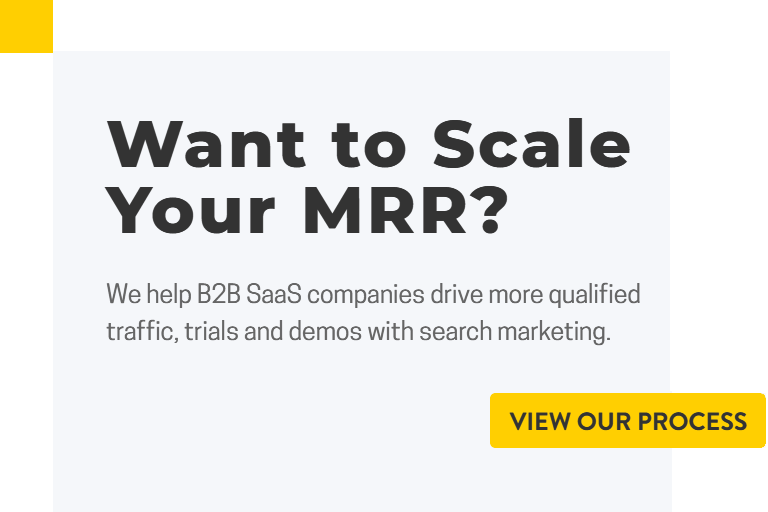Every so often, a new technology reshapes how we think about search engine marketing. Enter Google’s Search Generative Experience (SGE). Born from the rapid advancement of artificial intelligence (AI) and technologies like ChatGPT, SGE is poised to transform Google search like never before.
Virayo believes in staying ahead of the curve. As we closely monitor SGE’s development, a few questions are on our minds: How will SGE affect SEO? Will rankings and website traffic drop? How can we help our clients adapt and thrive?
Our team is gathering early insights and observations as we actively explore SGE and its implications on SaaS SEO. While sharing our perspectives as we continue to research is valuable, remember that SGE is still new, and many unknowns remain. Our goal is to provide clear and accurate information to guide your decisions.
The Emergence of SGE
In May 2023, Google introduced the beta version of its next groundbreaking innovation, the Search Generative Experience (SGE). Google Search’s new vision integrates generative artificial intelligence (AI) to offer users a more personalized and accurate search experience.
Google is no stranger to artificial intelligence. In 2001, Google began using machine learning to provide spelling suggestions and corrections in search. Google Translate followed in 2006. The company made history in 2015 with the release of TensorFlow, an open-source machine learning framework that accelerated AI development and research worldwide.
In 2023, advanced tools such as Bard, an AI-powered chatbot that answers questions fluently in human language, and SGE will redefine Google’s search experience. SGE is currently only available as an experiment through Search Labs, but the full version will likely be available to all users shortly after the lab experiment ends in December 2023.
A Look at SGE: How It Shows up in SERPs
Until SGE fully rolls out, users with personal Google accounts can test it through Google’s Search Labs. Corporate accounts via Google Workspace aren’t yet available.
If you’re interested in trying SGE, first opt into Search Labs. Once you’ve opted in, you can access SGE’s features through most Google searches.
SGE features

SGE search results produce a unique result called the Generative AI snippet. The snippet is easily distinguished from the rest of the SERP at the top of the page, with vibrant background colors that change with each query. The Generative AI snippet doesn’t replace the traditional SERP, so you can scroll past it and see the familiar results.
When you examine an SGE result, you’ll notice several key elements:
- Text-based GenAI answer
- Snapshot Carousel with three websites
- Source links and further questions
The snapshot above provides a text answer relevant to the user’s search for “website builder,” along with a Snapshot Carousel of three relevant websites. The Carousel sites verify the AI findings and suggest further exploration. Below, there’s a list of links of links and descriptions pertinent to the search.
As we’ve explored SGE, we’ve noticed that search intent determines the content and appearance of the Generative AI snippets. For informational inquiries, you’ll see results similar to traditional featured snippets. Vertical search intent, however, such as finding a product or service, yields different results.

Local SGE searches return a response similar to the familiar local results pack. For instance, a search for “website building near me” displays a list of nearby web design and digital companies and their ratings, along with a Snapshot Carousel of three recommendations.
The Generative AI snippet will also directly answer the user’s query, such as “There are many places to build a website near you…” and share a map featuring the locations of the results.
What Does SGE Mean for SEO?
The rise of SGE is transforming the industry, leaving many wondering: What does the rise of SGE and generative AI mean for the future of SEO?
In our experience, one thing is sure: no matter where or how we search for information, consumers always want information about brands, and brands work hard to attract them. So whether through a traditional SERP, an interactive generative search experience, or a holographic flyer, there will always be an opportunity to connect companies with their audiences.
All that changes is our strategy.
SGE Observations: What’s Next for SEO
As we prepare to optimize SGE results, the critical thing to remember is that SGE doesn’t replace organic search results—it complements them. As a result, SEO professionals need to optimize content for both SGE and SERPs.
Using our observations and insights from experts across the web, we’ve identified key elements to keep an eye on as SGE SEO evolves.
SGE will eat the top of the funnel

SGE provides comprehensive answers to user inquiries directly within the search engine through direct response, a list, or multimedia content. These enhanced results, called zero-click results, satisfy users’ needs immediately, bypassing the need to visit individual sites.
For example, if a user searches “what is data governance,” SGE will answer their question directly in the Generative AI snippet. The information they need is available without having to visit a website.
Zero-click results will significantly impact typical top-funnel content, such as basic “what is” and “how-to” queries. Some sources estimate a fall of 15% or more of traffic.
SGE uses third-party reviews and listicles

When users search mid-funnel queries, especially those seeking recommendations like “best field sales software,” SGE frequently pulls information from a mix of trusted review platforms. Renowned sites like G2, Capterra, TrustPilot, GetApp, and SoftwareAdvice are often the primary sources.
But SGE doesn’t stop there—it also references listicles from affiliate websites and niche industry blogs. This approach ensures users receive a comprehensive answer.
SGE’s reliance on third-party reviews emphasizes the importance of maintaining a good online reputation and being visible on platforms used by your target market.
GenAI appears to rely heavily on pricing and features


We tested how Bard selects its recommended solutions, and one thing consistently stood out across dozens of different SaaS industries—results always cite the feature set and pricing information.
Offering transparent and comprehensive information about your product’s features and pricing structures is crucial for businesses looking to optimize their online visibility and ranking. In addition to improving search representation, clarity enhances the user’s experience.
SGE optimization doesn’t require site-wide changes
Achieving optimal SGE placements doesn’t require massive site-wide transformations. You can gain good results by focusing on granular, page-specific refinements:
- Technical setup: Ensure pages load quickly, are mobile-friendly, and are free from crawl errors.
- E-E-A-T standards: Enhance your experience, expertise, authoritativeness, and trustworthiness indicators, such as by linking author bios and providing transparent sources.
- Internal linking: Strategically direct users to other relevant content within your site, bolstering the overall user experience.
- Backlinks: Acquire authoritative backlinks, underlining your content’s value and relevance.
- On-page content: Optimize meta descriptions, titles, and keyword placements without compromising readability.
Gilad David Maayan endorsed this hands-on, pinpointed strategy during a recent webinar with Search Engine Land. For deeper insights, we recommend watching the full webinar.
SGE sources aren’t always top-ranking sites


Our analysis of SGE’s Snapshot Carousel reveals an intriguing pattern—they don’t always reference the top three organic listings. Instead, specialized websites that offer depth and topical expertise frequently appear in the carousel.
While this may be disappointing for those with highly-ranked websites, it’s a silver lining for smaller, more niche sites. Brands previously overshadowed by larger competitors can still appear even if they don’t rank among Google’s top three.
Interestingly, our analysis suggests that nearly 50% of links in the SGE carousel aren’t even within Google’s top 10, highlighting the evolving dynamics of search visibility.
SGE will create a more competitive PPC auction
SGE results pages frequently display ad packs above the Generative AI snippet. However, these ad packs often contain fewer advertisements than in the past. As a result, competition will intensify for pay-per-click (PPC), resulting in changes for SaaS PPC services.
A notable change will be higher costs-per-click (CPCs) for brands aiming to maintain or capture visibility above the SGE. In addition, as SGE affects top-funnel traffic, brands might find their retargeting audiences either diminishing or expanding at a reduced pace. This could lead to decreased overall conversions for brands that rely heavily on retargeting campaigns.
GenAI leans on Expertise and Experience signals
In 2022, Google introduced “experience” into its Quality Rater Guidelines with the E-E-A-T update, emphasizing the importance of content rooted in genuine expertise. Many SaaS success stories we’ve seen since were those that published independent research and sought industry endorsements to demonstrate their knowledge.
Including expert insights, independent studies, and recognitions like G2 badges in your content is the key to excelling in SGE results. Real-world expertise is essential, especially as basic AI-generated content becomes more prevalent.
Preparing for SGE: Immediate Next Steps
SGE’s influence is multiplying, so staying ahead of the curve requires adjusting and refining our strategies. With predictions indicating SGE will reach an even larger audience by 2024, the worst thing to do is wait.
Here are the top two things to focus on as we approach Q4 2023 and the new year.
1. Perform an SGE impact assessment
Conducting a proactive analysis is the first step to anticipating changes and strategizing effectively. Here’s our methodical approach:
- Identify critical pages: Focus on the pages that contribute over 70% of organic traffic.
- Designate primary keywords: Assign each URL a chief keyword.
- Test for SGE results: Check if the assigned keyword generates SGE output.
- Determine client visibility: Note where the client appears in the SGE results.
- Estimate traffic shifts: Predict organic traffic changes using Click-Through Rate (CTR) estimates.
While this isn’t an exact science, it gives us an idea of which of our clients’ most important keywords are at risk. After this, we can test our ability to rank the high priorities in SGE.
Aim to complete this assessment before SGE’s full-scale launch, expected around late 2023 to early 2024.
2. Start running experiments for SGE placement
After identifying potential impact areas, the next step is to optimize for better visibility within SGE.
For keywords of high strategic value that rank in the top 10 but don’t appear in SGE, you need an action plan:
- Analyze on-page factors: Review content quality, keyword optimization, and user experience elements.
- Adjust off-page factors: Consider backlink quality, domain authority, and other relevant signals.
- Test and iterate: Monitor the keyword’s performance after making adjustments. Refine and retry if it doesn’t make it into SGE.
With this ongoing process, you can identify which factors SGE prioritizes, giving your content a better chance of placing prominently in results.
SGE Optimization Best Practices
There’s no one-size-fits-all approach to SGE optimization. Technical SEO for SaaS and page-level adjustments that improve SGE placement vary from industry to industry and keyword to keyword. We’ll continue to test as the tool rolls out, but in the meantime, we’ve observed a few trends in well-ranking content that can be useful.
The following are a few general recommendations for optimizing your website for SGE.
Use a blended search strategy
B2B SaaS keywords face tough competition on today’s search pages. Alongside AI-generated responses, brands will also compete with paid ads, “People Also Ask” boxes, and results from big aggregator sites like G2 and Capterra. Large industry sites and affiliates add to this mix.
To stand out in the clutter, it’s essential to:
- Analyze your SERP data: Determine your organic ranking potential for your main keywords. Sometimes, aiming for the top three isn’t the best strategy.
- Invest in paid ads: Guarantee a visible spot at the top.
- Engage with third-party aggregators: Establish profiles on key aggregator platforms, solicit reviews, and consider sponsored listings for increased visibility.
- Partner with high-ranking sites: Team up with sites that consistently rank well for your target keywords. Partnering with or sponsoring these sites can boost visibility.
- Expand your SERP presence: Aim for spots in video carousels or image packs. The more places you appear, the better.
For critical keywords, aim for a well-rounded presence: paid ads, mentions in SGE, spots on review sites, and regular listings. Getting your brand seen everywhere is the key. A unified strategy requires SEO and PPC teams to work closely together.
Focus on reputation management and review strategies
With SGE, your brand’s reputation is more important than ever. Ensure your company has detailed profiles on all major third-party review sites, especially those frequently referenced by SGE, like G2 and Capterra. Make it a priority to encourage satisfied customers to share their positive experiences and stay on top of monitoring. You should be attentive to customer reviews and handle negative feedback professionally.
While many review platforms provide tools to gather feedback, we’re also here to help automate and optimize the process, resulting in a consistent stream of genuine reviews.
Let SGE references guide link-building and paid placements
When planning your campaigns, look at the sources frequently appearing in SGE results. By targeting these sites for backlinks, your brand doesn’t just gain authority in traditional search rankings—it also gets a better shot at being noticed when Google’s AI compiles the SGE answer.
This dual benefit is something we’re actively exploring with our clients. Reverse engineering referenced sources in SGE results and other web source snippets offer an opportunity to target outreach campaigns effectively for a solid foothold in both the traditional and emerging SGE search landscapes.
Focus your keyword strategy on the mid-bottom funnel
As SGE becomes more prevalent, top-funnel searches will likely result in zero clicks since Generative AI snippets will answer user queries directly. Using mid-bottom funnel keyword targeting can help you navigate this transition. The more tailored content you provide your users, the more likely they are to click and convert.
However, for SaaS companies that still want to target top-funnel queries, highlighting your brand’s expertise and experience will be more critical than ever. Internal subject matter experts should write or review all content before going live. Offering insights only human experts can provide will ensure your content stands out from AI-generated results.
Provide comprehensive feature page coverage
Take advantage of Google’s evolving search capabilities by optimizing your feature pages thoroughly. Describe features and capabilities in detail and offer case studies and customer stories. In addition, make sure to include key features and benefits on your home page, as this will help Google understand your site and increase its chances of being featured.
The more detailed and comprehensive these pages are, the more likely they will rank well in SGE. By providing Google with all the necessary information, you also increase the chances that AI will recognize your product as a top solution.
Layer expertise and experience signals into content
Make a list of your most valuable content assets, the ones you’re most concerned about protecting. Then, examine these assets through the lens of Google’s Helpful Content System, focusing on Expertise and Experience.
A total content rewrite isn’t always necessary, but enhancing your content with elements that demonstrate expertise is vital. Consider obtaining a quote from a customer or seeking insight from internal or external experts to support a particular point. Including these experience signals makes your content more authentic and better aligned with search criteria.
Moving forward, we’re making this approach a standard part of our content relaunch strategy.
Build strong topical relevance around product/feature terms
In our exploration of SGE, we were surprised to find that AI-generated responses don’t always come from top-ranking sites. Instead, smaller websites with specialized content appear frequently in the Snapshot Carousel and snippet. This suggests that strong topical authority increases your chances of performing well in SGE.
Creating topical clusters around a primary product, feature, and solution pages is an effective strategy to boost authority. Be sure to fully explore each topic’s keyword potential before moving on to the next.
Additionally, strategic internal linking from related content to these main pages can significantly boost your site’s authority and relevance.
Are You Ready for Generative AI search? We’re Here to Help
As SEO prepares for the rise of SGE, we’re reminded that change often brings innovation and growth. History shows us that each Google update is an opportunity to refine strategies and stand out, and we’re confident that the SGE update will be no different.
At Virayo, we’re not just watching the horizon—we’re actively analyzing SGE’s potential impact on our clients. Our expert team has the knowledge and experience you need to prepare for the SGE update and position your business for success.
Let us help you make the most of the SGE update. Schedule a free 15-minute call to chat about an SGE impact assessment.
FAQ: Google’s Search Generative Experience (SGE)
What is Google’s Search Generative Experience (SGE)?
When will SGE be available to all users?
Will SGE affect website rankings and traffic?
What does the rise of SGE mean for the future of SEO?
How does SGE impact organic search results?
How are zero-click results affecting site traffic?
Do businesses need to make extensive site-wide changes for SGE optimization?
What should I focus on as SGE’s influence grows?




